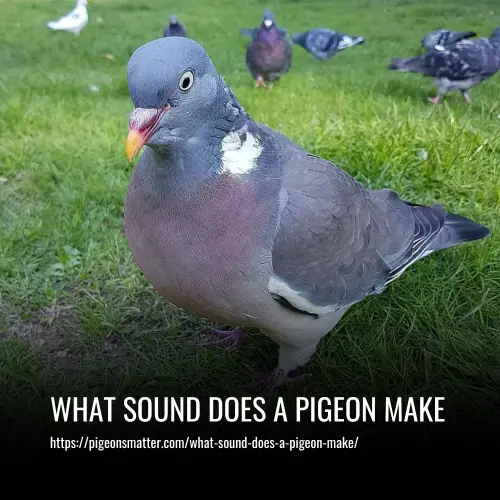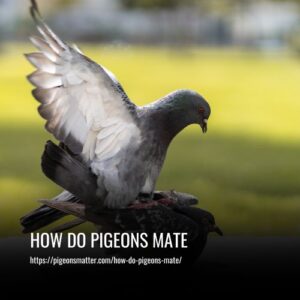Pigeons make cooing and grunting sounds, which are their most common vocalizations. Baby pigeons may squeak and whistle to communicate with their parents, and they may hiss if they feel threatened by a predator. Pigeons also make sounds with their wings and feet before takeoff and during flight.
Different Types Of Sounds That Pigeons Make:
- Cooing
- Singing
- Wing Beating
- Grunting
- Chirping
- Clicking
- Whistling

Different Sounds That Pigeons Make
Pigeons are generally quiet birds, but they do make occasional sounds to communicate important messages. Here are some main sounds pigeons produce.
1. Cooing
Pigeons commonly make cooing noises, which are quiet and soothing sounds. This is often a mating call, particularly during the spring and fall mating seasons. However, not all pigeons bred in captivity will make this sound. They may communicate with each other through cooing, which can have varying frequencies to convey different messages.
It is important to note that pet pigeons living alone may not make cooing sounds as they don’t have other birds to communicate with. Cooing sounds are typically not disruptive and should not be a cause for concern.
2. Singing
While pigeons do not typically sing like other birds, there have been instances where they have produced song-like mating tunes. These songs are similar to cooing noises but have slight variations in sound. Pigeons may sing for extended periods when searching for a mate, altering the strength, pitch, and tone of their cooing to create a pleasant melody.
You can often tell if it is a mating call by observing the pigeon’s behavior, such as walking proudly or displaying their feathers.
3. Wing Beating
Some pigeons beat their wings before flying, signaling to other birds that they are leaving the area. This behavior is often seen in wild pigeons and can be a way for them to stay together as a group. Wing beating may also serve as a mating dance in certain pigeon species. Even if a pigeon cannot fly or has clipped wings, they may still instinctively beat their wings.
4. Grunting
Pigeons may make a grunting noise, which is generally a sign of an issue. It can indicate pain, injury, or the presence of predators. Pigeons are prey birds and do not show signs of being hurt in order to avoid being targeted. If you notice your pigeon grunting frequently, it is important to address the problem. If you are unable to resolve the issue, taking your bird to a vet can provide appropriate care.
5. Chirping
Pigeons make chirping noises, which are louder and more high-pitched than their cooing sounds. Chirping is often used by pigeons to communicate with each other or to warn of potential danger.
6. Clicking
Pigeons also produce clicking sounds using their beaks. This clicking noise serves as a form of communication with other pigeons or as a signal that they are searching for food.
7. Whistling
Pigeons can create whistling noises while flying or when perched on high surfaces like roofs. This whistling sound is produced by the movement of air through their feathers and is used as a means of communication or to announce their presence to other birds.
Overall, pigeons are quiet birds, and any sounds they do make are usually related to mating or important communications. These sounds should not be overly disruptive or concerning and are simply a natural part of pigeon behavior.
What Sound Does a Baby Pigeon Make
Pigeon chicks communicate through high-pitched peeps instead of the deep coos of adult birds until they are around seven to eight weeks old. These whistling and wheezing sounds are a sign that baby pigeons are present. Once you become aware of these calls, you’ll realize that there are hidden pigeon nests all around. The chicks use their cries to communicate and attract attention, indicating their presence to others.
What Sounds Does A Pigeon Make When Around A Human
When pigeons are around humans, they may make various sounds depending on their individual characteristics and the situation. Common sounds include cooing, chirping, clicking, and whistling. These sounds can indicate different emotions or behaviors in pigeons, such as contentment, excitement, alarm, or the search for food.
Additionally, pigeons may make sounds while flying or perched on a high place. Paying attention to these sounds can provide insights into the pigeon’s state of mind or activities.
Do Pigeons Only Use Sounds To Communicate
Pigeons communicate not only through vocalizations but also through body language and gestures. They use various movements and postures to convey different meanings and intentions.
1. Puffing Out the Chest
One form of body language used by pigeons is puffing out their chest. This behavior indicates dominance or aggression, signaling to other pigeons that they are in charge or asserting their dominance over another pigeon.
2. Shaking Tail Feathers
Pigeons may also shake their tail feathers to display aggression or dominance. This movement, often accompanied by chest puffing, is used to intimidate other pigeons or establish dominance in a particular situation.
3. Bobbing the Head
Another common gesture is head bobbing, often accompanied by cooing. Pigeons use this movement to show interest in a potential mate. They may also wag their tail to indicate their interest.
FAQs
When a pigeon coos, it can have various meanings. One common reason is to attract a mate for breeding. Pigeons may also coo to protect their territory from predators or to assert dominance over other pigeons, especially when there is a clash between two male pigeons. In addition to cooing, pigeons may display physical movements such as feather display, bowing, and tail movement to intimidate their opponents.
Pigeons will purr to communicate and socialize with other pigeons. Similar to cats, purring is a way for pigeons to express that they have a strong bond with each other and that they are feeling happy. Purring is commonly done in larger groups as a form of their socialization process.
Pigeons make a low, continuous sound when flying. It’s a soft whistling sound caused by their wings flapping in the wind. However, if they are trying to warn nearby pigeons of a threat, they can flap their wings louder to make a louder noise.
Conclusion
Pigeons have an impressive range of sound-producing behavior that allow them to communicate effectively with one another and survive in the wild. From baby pigeon chirps to loud cooing noises, there are many types of sounds that pigeons make. In addition, they use wing claps, prolonged coos, and mating dances during specific seasons to attract mates.
Wild pigeons can also alert their flock when predators are near using distinct vocalizations. Pigeon owners should be aware of these sound-producing behaviors in order to properly care for their feathered friends. With knowledge and understanding, people can appreciate the different ways that pigeons communicate with each other!


